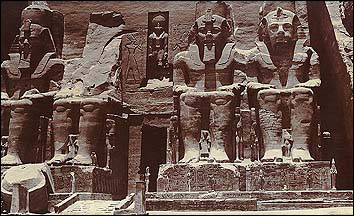
Silver gelatin on
glass 29 x 40 cm Epigraphic Survey, Oriental Institute, University of Chicago |
Temple
of Abu Simbel.
Abu Simbel is on the west bank of the Nile, 280 km (180 miles) south of Aswan, in the ancient and now submerged land of Nubia. The area of the temple was called "the Domain of Ramesses-Beloved-of-Amun." Built by Ramesses II, it was rediscovered for the western world by Johann Ludwig (Jean-Louis) Burckhardt in 1813. The colossus to the left of the central portal probably broke apart due to seismic activity already during the second half of the reign of Ramesses II. Of the features of the colossi, Amelia Edwards wrote: "A godlike serenity, an almost superhuman pride, an immutable will, breathe from the sculptured stone. He has learned to believe his prowess irresistible, and himself almost divine. If he now raised his arm to slay, it would be with the serene placidity of a destroying angel." Beginning in 1963, the temple of Ramesses II and the smaller
neighboring temple to his wife, Nefertari, were cut into blocks and
removed to higher ground to save them from the rising waters of Lake
Nasser, the huge reservoir behind the Aswan High Dam. This photograph was
taken after Alexandre Barsanti completed his restoration work on the
temples in the years 1909-1910. |
| » 1 : Temple of Abu Simbel 2 3 4 5 6 7 8 9 10 |